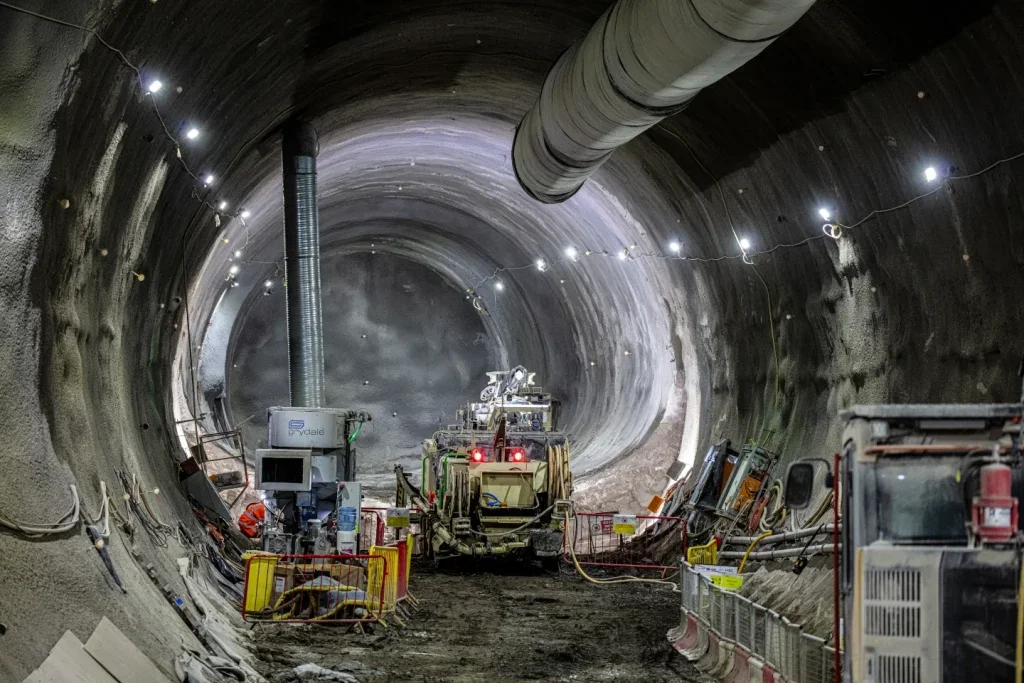
Engineers have begun assembling the two TBMs to dig the 7.5km-long Euston Tunnel that will carry HS2 trains into the heart of London.
The Herrenknecht TBMs will launch from an underground box at one end of the project’s Old Oak Common station. They are expected to take around one-and-a-half years to reach the railway’s southern terminus at London Euston.
They take to 10 the number of TBMs used for the deep bored sections of the 225km route between London and the West Midlands.
The 190m-long TBMs each weigh 1,250 tonnes. During the summer, they were lifted into the underground station box using a 750-tonne crane. They are now being reassembled at the eastern end of the station, ready to bore to Euston.
The cutterhead of the machine, which has been optimised for London clay, has an 8.53m diameter, and the inner diameter of the tunnel will be 7.55m. They will make an average daily advance of 16m.

The approach to Euston will be completed by sprayed concrete lined tunnels which will then transition into three tunnels, which will enable trains to be fed into and from platforms at Euston station.
One of the machine’s has been named Karen after Karen Harrison (1960-2011), the first female train driver in the UK, who was based out of Old Oak Common depot. The other is named Madeleine, after Madeleine Nobbs (1914-1970), a former president of the Women’s Engineering Society.
The unveiling of the final TBMs for the high-speed railway came on the day that Mark Wild took over as HS2 Ltd’s new chief executive. Wild, the former CEO of Crossrail, will help oversee the project’s transition from a major construction programme to a working railway, with a renewed focus on controlling costs.
Rail minister Lord Hendy welcomed Mark Wild to HS2.
“The sheer scale of the progress at Old Oak Common – and the benefits we will realise from taking HS2 to Euston, as confirmed in the Budget – reminds us that this is a once-in-a-generation project. HS2 will not only improve transport links for millions but unlock huge potential for growth, jobs and regeneration right across the country,” he said.
The Mayor of London, Sadiq Khan, said it was exciting that the TBMs would be launched soon.
“After so much uncertainty, it’s great to finally be working with a government that recognises the huge importance of this scheme to London and the UK, and understands why terminating HS2 at Euston is so important,” he said.
The government gave the green light for the tunnel between Old Oak Common and London Euston in the Budget in October.
HS2’s London tunnels contractor, Skanksa Costain Strabag (SCS) joint venture, is leading construction of the twin-bored tunnel. In January this year the team completed the 853m-long Atlas Road Logistics Tunnel which will provide access for materials, and a route to remove the excavated London clay. It has also built two spray concrete-lined tunnels from which the TBMs will be launched eastwards towards Euston. Boring is expected to begin in 2025.
SCS is already well advanced with construction the Northolt tunnel – a separate structure running west out of Old Oak Common towards West Ruislip.
SCS managing director James Richardson said the joint venture was delighted the government had given the green light to delivering HS2 through to Euston.
“Over the past two years, we have continued with critical activities to ensure that we can deliver the Euston Tunnel and approaches quickly, and at the lowest possible cost,” he said. “We are also making excellent progress on the tunnelling between West Ruislip and Old Oak Common, with four TBMs in operation, and the works well over 50% complete.”
Final plans for HS2’s terminus station at Euston are still under review and HS2 Ltd is continuing to work with the government and other stakeholders to an affordable station design. Further details will be announced by the government in due course.







